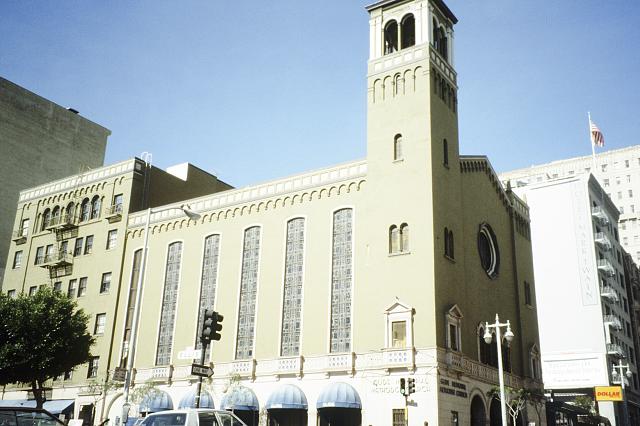Mark Wild. 2019. Renewal: Liberal Protestants and the American City After World War II. Chicago, IL: University of Chicago Press, 336 pp. $50. ISBN: 978-0226605234. Hardcover.
In some ways, the idea for this book began during my childhood in 1970s-era San Francisco. The city in those years was much more dynamic, much more interesting, and much scarier than it is today. This was as true of the city’s Protestant religious communities as anything else. A few examples: In the Tenderloin district, the once fading Glide Memorial Methodist church had transformed under the leadership of pastor Cecil Williams into a thriving interracial congregation with an international reputation and a substantial local political presence. Not far away (and just a few blocks from my home), Jim Jones’s People’s Temple had acquired a comparable level of publicity, while rumors about its cultish and treacherous leader foreshadowed the carnage that followed the temple’s relocation to Guyana. Even our family’s church—a staid, white Episcopalian congregation in a well-to-do neighborhood—was not insulated from the forces of cultural change. One Sunday morning in 1978, the associate rector, William Barcus, announced that he was gay. At the time, such a declaration from a mainline clergyman was shocking, even in San Francisco. Father Barcus went on to deliver the eulogy at Harvey Milk’s funeral and to establish a homeless ministry before dying of AIDS-related complications in the early 1990s.
 Renewal investigates a problem that vexed many people in the years after World War II: how should the church respond to the volatile climate of modern urban America? One movement of mainline clergy and laypeople believed that new kinds of ecclesial institutions were needed. Capital flight and suburbanization were luring the middle-classes, especially the white middle class, out of cities. Their replacements were more working-class, more racially and religiously diverse. The renewalists argued that mainline congregations no longer served the needs (spiritual, social, and political) of these parishioners. They designed new forms of ministry and spiritual community to appeal to these residents. Along the way they rethought the church’s relationship to the city. Hoping to abolish, or at least reduce, the distinction between sacred and secular, they carved out a vision of a church embedded in all dimensions of urban America.
Renewal investigates a problem that vexed many people in the years after World War II: how should the church respond to the volatile climate of modern urban America? One movement of mainline clergy and laypeople believed that new kinds of ecclesial institutions were needed. Capital flight and suburbanization were luring the middle-classes, especially the white middle class, out of cities. Their replacements were more working-class, more racially and religiously diverse. The renewalists argued that mainline congregations no longer served the needs (spiritual, social, and political) of these parishioners. They designed new forms of ministry and spiritual community to appeal to these residents. Along the way they rethought the church’s relationship to the city. Hoping to abolish, or at least reduce, the distinction between sacred and secular, they carved out a vision of a church embedded in all dimensions of urban America.
A few of these efforts, like Glide Church, enjoyed spectacular success. Most did not. Renewalists envisioned unified parishes and the simultaneous empowerment of the diverse ethnic, racial, and cultural communities within them. Balancing unity and autonomy was (and remains) notoriously difficult, and by the time I was going to church, renewalists had lost much of their energy and resources.
Why should urban historians care about a movement that failed to achieve most of its objectives? For one thing, renewalists, despite their limitations, had a significant impact on the communities where they worked, not only through their own ministries, but by supporting the larger network of community organizations and campaigns that reshaped urban America in the postwar period. For another, renewalist efforts bear striking similarities to those of other institutions—freedom-movement and ethnic nationalist organizations, unions, and local political machines, to name a few—of their era. When Father Barcus came out to our congregation, he did so partly to protest a state referendum, sometimes referred to as the Briggs initiative, that would have barred LGBT teachers from public schools. The coalition that mobilized to defeat Briggs spanned local and regional organizations, both secular and church-based. These kinds of subjects have occupied the attention of urban historians for a long time. Understanding them requires understanding the church people who supported and sometimes led them. These renewalists were not just the religious arm of a secular cause, but active constituents in the evolution of urban history, whose stories hold lessons for people inside and outside the church.
Mark Wild has taught history at California State University Los Angeles since 2002. In addition to Renewal, he is the author of Street Meeting: Multiethnic Neighborhoods in Early Twentieth Century Los Angeles (University of California Press, 2005).
Featured image (at top):
- Glide Memorial United Methodist Church, renovation, San Francisco, CA, photo by Beverly Willis, 1966, Prints and Photographs Division, Library of Congress.


